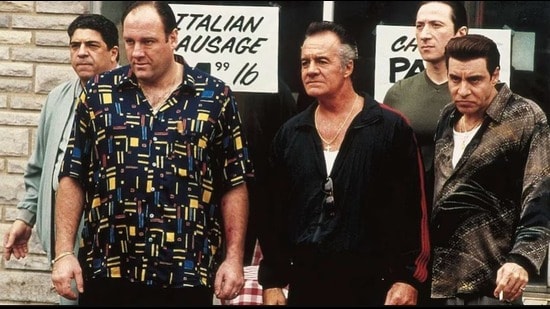
THE STREAMING WARS ARE OVER, AND YOU’VE LOST
“Lately, I’m getting the feeling that I came in at the end. The best is over.”
That was the mob boss Tony Soprano, in a pilot episode of The Sopranos, a show that would set new standards for storytelling on the small screen, as it ran to popular and critical acclaim from 1999 to 2007.
Lately, viewers have been getting the same feeling, not about their crime families (so few of us have those), but about our watchlists.
The number of shoddy spinoffs alone might have prompted Soprano to pull a gun.
There is so much new content, yet so little worth watching. So much time and money spent, to produce shows that are all icing and no cake (such as Emily in Paris, now in its fourth season).
In April, The New York Times chief TV critic James Poniewozik called this “the golden age of Mid TV”. He described the term as “what you get when you raise TV’s production values and lower its ambitions”.
How did we get here, from the era of Prestige TV that took off with The Sopranos (one of HBO’s early experiments with the original-series format, for cable)?
Freed from the fetters of mainstream television, these series could target the adult rather than the family; depict drug use and cursing, sex and violence. As a result, storytelling blossomed in strange and riveting new ways.
Six Feet Under (2001-05; HBO) told a darkly funny tale built around a dysfunctional family of undertakers. The Wire (2002-08; HBO) explored biases of race and class, and the misuse of power by cops. Other networks joined in, with shows such as Lost (2004-10; ABC), Mad Men (2007-15; AMC) and Breaking Bad (2008-13; AMC).
“TV was the new literature, back then,” says columnist, writer and translator Poonam Saxena. “These were shows that left a cultural mark”.
They dug deep to explore questions that dated to the earliest myths: How does anyone come to terms with the ever-presence of death; what would really happen if a group of people was trapped on a deserted island; what does greed do to ideas of self and family?
Amid the rise of the smartphone and smart TV, streaming platforms took the model mainstream, with shows designed to be so unmissable that they drew new subscribers in.
Game of Thrones (2011-19) helped boost HBO Go in this way, a year after the platform’s launch. House of Cards (2013-18) was so widely discussed that it prompted otherwise disinterested people to ask: What is a Netflix?
Netflix would use this tactic over and over, with shows such as Narcos (launched in 2015); The Crown, launched in 2016, the year of its big push into new territories, including India; Sacred Games, launched in 2018 and aimed at a wider audience within India.
By 2015, Amazon Prime’s big hit, Transparent (2014–19; about a father and grandfather embracing his identity as a woman) had become the first streaming show to win the Best Series award at the Golden Globes. By 2021, Netflix, HBO and Apple TV+ were sweeping up Emmies, for series that included The Crown, Hacks and Ted Lasso.
This golden age would also see the release of titles such as Chernobyl, Succession and The Last of Us (HBO), The Irishman, Sacred Games and Snowpiercer (Netflix), Severance, Slow Horses and The Morning Show (Apple TV+).
Seasonal changes
Numbers were rising. Excitement was high. But subscriber numbers largely failed to reach the levels expected, and then plateaued. This created a sense that the big shows based on new ideas had not paid off.
“Platforms are now less inclined to experiment with new and interesting ideas,” says film and TV critic Suchin Mehrotra.
The soaring demand for content during the pandemic, which drove a shift to volumes and widespread appeal, over fine-tuned quality, finally began to take its toll.
“Today, most of the original shows being greenlit are ones being made on a very low budget or with mass appeal and big talent attached,” Mehrotra says.
Most streamers have stopped taking risks, adds Saxena. “The desire to top the streaming charts is eerily reminiscent of the TRP-driven era of Indian television that led to the proliferation of saas-bahu sagas.”
Another key factor in the rise of Mid TV has been the demise of the writers’ room.
In an effort to keep costs down, platforms rely on “mini-rooms” with just a handful of writers and a showrunner. The writers are often freelancers and may not stick around, which explains why so many second seasons seem to simply fall away.
Another term for Mid TV, he adds, is “TV plus”. “This is something that sits between Prestige TV and TV soaps. It is typically a diluted, less expensive, less challenging and more accessible show that stretches out over 30 to 40 episodes and is designed to woo a larger audience. It usually ends up being just well-packaged crap.”
There will always, thankfully, be exceptions. Netflix’s new dark comedy, Kaos, starring Jeff Goldblum as the Greek god Zeus trying to navigate faith and power in a modern-day version of Greece, is a well-knitted, dynamic example. Apple TV+ has Season 2 of Shrinking (about the private lives of exclusive therapists in California) due out next month, and the long-awaited Season 2 of Severance due out next year.
“It takes some sifting through the glut, but there are shows that have not received the love they deserve and might be able to scratch that itch,” Mehrotra says. When that happens, it just reinforces the vicious cycle, and so it goes.
Maybe they could make a series about that.
Read more news like this on HindustanTimes.com
2024-09-13T11:40:12Z dg43tfdfdgfd